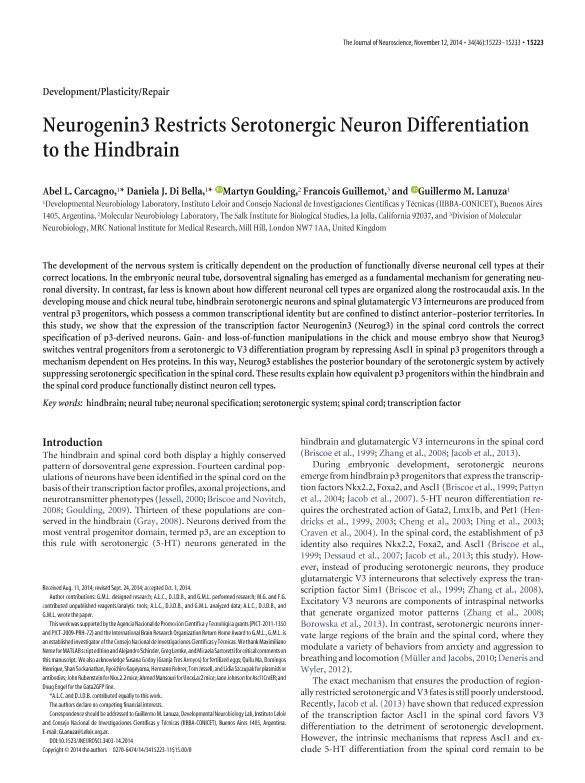Mostrar el registro sencillo del ítem
dc.contributor.author
Carcagno, Abel Luis

dc.contributor.author
Di Bella, Daniela Jesica

dc.contributor.author
Goulding, Martyn
dc.contributor.author
Guillemot, Francois
dc.contributor.author
Lanuza, Guillermo Marcos

dc.date.available
2017-08-28T18:31:53Z
dc.date.issued
2014-11
dc.identifier.citation
Carcagno, Abel Luis; Di Bella, Daniela Jesica; Goulding, Martyn; Guillemot, Francois; Lanuza, Guillermo Marcos; Neurogenin3 restricts serotonergic neuron differentiation to the hindbrain; Society for Neuroscience; Journal of Neuroscience; 34; 46; 11-2014; 15223-15233
dc.identifier.issn
0270-6474
dc.identifier.uri
http://hdl.handle.net/11336/23131
dc.description.abstract
The development of the nervous system is critically dependent on the production of functionally diverse neuronal cell types at their correct locations. In the embryonic neural tube, dorsoventral signaling has emerged as a fundamental mechanism for generating neuronal diversity. In contrast, far less is known about how different neuronal cell types are organized along the rostrocaudal axis. In the developing mouse and chick neural tube, hindbrain serotonergic neurons and spinal glutamatergic V3 interneurons are produced from ventral p3 progenitors, which possess a common transcriptional identity but are confined to distinct anterior-posterior territories. In this study, we show that the expression of the transcription factor Neurogenin3 (Neurog3) in the spinal cord controls the correct specification of p3-derived neurons. Gain- and loss-of-function manipulations in the chick and mouse embryo show that Neurog3 switches ventral progenitors from a serotonergic to V3 differentiation program by repressing Ascl1 in spinal p3 progenitors through a mechanism dependent on Hes proteins. In this way, Neurog3 establishes the posterior boundary of the serotonergic system by actively suppressing serotonergic specification in the spinal cord. These results explain how equivalent p3 progenitors within the hindbrain and the spinal cord produce functionally distinct neuron cell types.
dc.format
application/pdf
dc.language.iso
eng
dc.publisher
Society for Neuroscience

dc.rights
info:eu-repo/semantics/openAccess
dc.rights.uri
https://creativecommons.org/licenses/by-nc-sa/2.5/ar/
dc.subject
Hindbrain
dc.subject
Neural Tube
dc.subject
Neuronal Specification
dc.subject
Serotonergic System
dc.subject
Spinal Cord
dc.subject
Transcription Factor
dc.subject.classification
Bioquímica y Biología Molecular

dc.subject.classification
Ciencias Biológicas

dc.subject.classification
CIENCIAS NATURALES Y EXACTAS

dc.title
Neurogenin3 restricts serotonergic neuron differentiation to the hindbrain
dc.type
info:eu-repo/semantics/article
dc.type
info:ar-repo/semantics/artículo
dc.type
info:eu-repo/semantics/publishedVersion
dc.date.updated
2017-08-14T19:55:27Z
dc.identifier.eissn
1529-2401
dc.journal.volume
34
dc.journal.number
46
dc.journal.pagination
15223-15233
dc.journal.pais
Estados Unidos

dc.journal.ciudad
Washington
dc.description.fil
Fil: Carcagno, Abel Luis. Consejo Nacional de Investigaciones Científicas y Técnicas. Oficina de Coordinación Administrativa Parque Centenario. Instituto de Investigaciones Bioquímicas de Buenos Aires. Fundación Instituto Leloir. Instituto de Investigaciones Bioquímicas de Buenos Aires; Argentina
dc.description.fil
Fil: Di Bella, Daniela Jesica. Consejo Nacional de Investigaciones Científicas y Técnicas. Oficina de Coordinación Administrativa Parque Centenario. Instituto de Investigaciones Bioquímicas de Buenos Aires. Fundación Instituto Leloir. Instituto de Investigaciones Bioquímicas de Buenos Aires; Argentina
dc.description.fil
Fil: Goulding, Martyn. Salk Institute for Biological Studies; Estados Unidos
dc.description.fil
Fil: Guillemot, Francois. MRC National Institute for Medical Research; Reino Unido
dc.description.fil
Fil: Lanuza, Guillermo Marcos. Consejo Nacional de Investigaciones Científicas y Técnicas. Oficina de Coordinación Administrativa Parque Centenario. Instituto de Investigaciones Bioquímicas de Buenos Aires. Fundación Instituto Leloir. Instituto de Investigaciones Bioquímicas de Buenos Aires; Argentina
dc.journal.title
Journal of Neuroscience

dc.relation.alternativeid
info:eu-repo/semantics/altIdentifier/url/http://www.jneurosci.org/content/34/46/15223.long
dc.relation.alternativeid
info:eu-repo/semantics/altIdentifier/doi/https://doi.org/10.1523/JNEUROSCI.3403-14.2014
Archivos asociados
